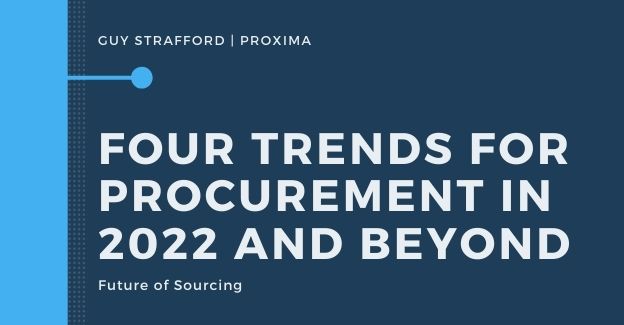CPOs at Fortune 50 companies are now looking at issues such as security of supply, energy prices, accelerating innovation, sustainability and Scope 3 CO2e emissions, says Guy Strafford, Executive Vice President at Proxima. While some of these current challenges will be long-term and more important than others, the question is how businesses will minimize the consequences.
Procurement has been an essential partner to businesses throughout the pandemic. While there are many factors that have led to its prominence, not all of them will have a long-term impact. In 2022, the tradtional function of procurement and the roles it performs will change drastically.
We can’t predict the future, but we can keep in mind the challenges and opportunities for 2022 and beyond. Procurement does not operate in a business vacuum and an important question to ask is how businesses will minimize the consequences of varying timelines for certain issues. Below, we explore four trends that are impacting the procurement function.
1. Dramatic Business Changes
The last two years proved once again that those who adapted and aligned themselves to the new 2020/21 business strategy fastest have done extraordinarily well. Power flows to those who know how to wield it and take advantage of circumstance.
Many CPOs have seen their remit expand to include property, sustainability, risk, supply chain, or overseeing corporate incubators or moving beyond procurement full stop, and their voices are being heard. When talking about gaining a seat at the table or delivering value beyond savings, this is what it means and what evolution reaps. If your remit has not expanded in the last 12 months, what have you been doing?
2022 will see more dramatic business changes. The CPOs who showed their worth during COVID will adapt to the next crisis and keep reinventing the positioning and narrative to remain prominent. The rest risk stagnation, or worse, still being replaced.
2. Building Resilience
We ran a good times supply chain model pre-2020. We all assumed that the just in time approach of undisrupted global supply chains would continue. But there were clues it would not. Case in point: the Japan nuclear reactor disaster of 2011 impacted the smooth running of the automobile supply chain, but CFOs responsible for managing the balance sheet put the pressure on their business to remove the spare stock and slack in the system because they (like the rest of us) thought that the boundaries of volatility that needed to be planned for were narrower than in actuality.
It has only belatedly been understood how social media amplifies consumer demand to overwhelm supply. In a lemming-like panic we buy toilet paper, PPE or petrol, fearful that others get there first. And we are now all equipped with a portable supercomputer pointing us to where the last remaining roll, mask or gallon is stored.
Into that mix, when COVID hit, every disaster plan was – to my knowledge – ignored. In conversation, I think many corporates have realized that risks are hard, if not impossible to anticipate, so there is a desire to create bigger buffers that provide protection. Some protection will be better visibility in the supply chain via e-tools to interrogate the public or coordinate private information about suppliers.
But the primary buffer in 2022 will be more stocks and fat in the supply chain to smooth the bumps. This will provide more resilience because more events will be covered, which would have previously caused a problem.
Of course, by 2030, a new generation of management will probably be in place, and the lessons from COVID will have faded from the executive memory, so expect pressure to mount soon to reverse these buffers until the next crisis. I already see that a wide range of executives did not remember the commodity volatility of the 2000s.
3. ESG As a Business Priority
If 2021 was about making promises on emissions, then 2022 is about figuring out how those promises will be kept! The rubber is genuinely hitting the road, but the road is slippery, and the GPS is not working well yet! However, four things are becoming clear:
- Companies will collaborate –To have the mass/momentum/credibility, non-competing businesses are cooperating to work with suppliers. As CPO of Diageo, one of the world’s largest producers of spirits and beers, Janelle Orozco is looking to work with businesses on glass industry emissions, and I have heard many other examples. The nature of the openness required from suppliers and cooperation with suppliers is going to increase. Interestingly, I think it will improve negotiations and be more fun as the variables will more clearly trade off price and carbon emissions.
- “Greenification equals localization.” We will see an acceleration of more local, automated supply chains, which will create more socially, environmentally friendly options, but which may force clarity on the trade-off between higher cost relative to what may be available elsewhere and lower carbon. Without appropriate guide rails such as “internal carbon taxes,” this will cause a lot of tension in 2022.
- Reporting will begin to tighten up – A material number of quoted businesses have reported numbers on carbon emissions which are at best fanciful. Companies will soon have to report on ESG factors impacting their business due to the rise of better auditing to verify reporting and the creation of the International Financial Reporting Standards’ (IFRS) International Sustainability Standards Board (ISSB) with standards for consistent and global ESG reporting. Both have a long way to go and 2022 will see some corporates get caught out as they start the journey. It is a natural stage of evolution for a nascent market.
- More information flows from suppliers – This is going to be the driver for procurement taking over sustainability in many companies. More and more tenders require information on environmental performance and the answers will be weighted accordingly; revenue will flow to the more sustainably-aware businesses. It is this link to future revenues and loss thereof which will drive business change.
Underlying monitoring and measurement tech to feed this beast will be the next big trend in procure-tech, something that solves a genuine business need beyond cost to serve. The answer is going to emerge in niches. There will be an explosion of niche e-tools and services because that happens at the start of any market prior to simplification and consolidation.)
4. Procuretech – The Revolution Will Eat Its Parents
The tough thing is that less clarity exists in defining the replacement entity overseeing the new commercial architecture, its role and its responsibilities. In 2022, procurement will likely shift more consistently into leading business into a new era. Suppliers, customers, regulators, investors – the boundaries in which businesses operate – have fundamentally changed or are changing. And the role of procurement is to make sense of that change, calibrate it and then interact with the “external enterprise” in an optimum way.
Digitizing, like ESG, is going to be an ongoing part of commercial life; while today they are separate, soon enough, they won’t be. However, the biggest companies are not looking for digital to make their function more effective. They are looking to it to remove the need for a procurement professional to do most of the things that we have done.
Sourcing, contracting, payment and negotiation will all be automated. In 2021, companies were experimenting and trying to sequence how this could be done. Some of the West Coast tech goliaths can see a route to revenues for them. Other big corporates see autonomous procurement or what I term “self-service procurement” as a way to deal with the tail. Either way, they need much more detailed data to apply algorithms and AI learning.
Automating the tail so stakeholders do not need human intervention from procurement is only the start. Multiple motives lead to one inevitable conclusion – the revolution will eat its parents.
Technology can enable the stakeholder to do most of what procurement does today without procurement, and AI will help it get better and better. To be genuinely autonomous, however, the technology must understand changing needs, open and competitive markets, non-standard behaviors human and technological behaviors. The tech needs to learn how to game.
Conclusion
2022 is a point of inflection for many. At the same time, procurement has made strides and will continue to do so. For procurement leaders, it will be incredibly important to keep in mind the shifting nature that these strides have occurred. We’ve come to know procurement as an evolving function throughout the pandemic compared to the old school responsibilities, and we should treat it as such.









